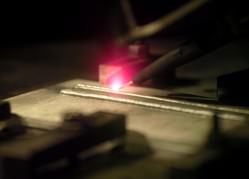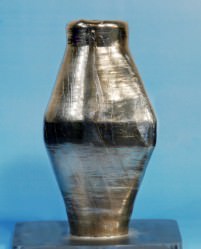[/caption]
It’s not quite like requesting “Tea, Earl Grey, hot” and having a steaming drink appear, but almost. The Electron Beam Freeform Fabrication, developed at NASA’s Langley Research Center, is an engineer’s version of the science fiction replicator on Star Trek. “You start with a drawing of the part you want to build, you push a button, and out comes the part,” said Karen Taminger, the technology lead for NASA’s Fundamental Aeronautics Program.

Electron Beam Freeform Fabrication or EBF3150 creates parts for airplanes — not food and drink — and uses an environmentally-friendly construction process to manufacture layered metal objects. This technique could revolutionize the aviation industry and may have applications for the future spacecraft and the medical community as well. It can be used to make small, detailed parts or large structural pieces of airplanes.
EBF3150 works in a vacuum chamber, where an electron beam is focused on a constantly feeding source of metal, which is melted and then applied layer by layer on top of a rotating surface until the part is complete. A detailed 3-dimensional cross-sectional drawing of the part is fed into the device’s computer, providing information of how the the part should be built from the inside out. This guides the electron beam and and the inflow of metal to produce the object, building it up layer by layer.
Commercial applications for EBF3150 are already known and its potential already tested, Taminger said, noting it’s possible that, within a few years, some aircraft will be flying with parts made by this process.
The metals used must be compatible with the electron beam so that it can be heated by the stream of energy and briefly turned into liquid form. Aluminum is an ideal material to be used, but other metals can be used as well. In fact, the EBF3150 can handle two different sources of the feed stock metal at the same time, either by mixing them together into a unique alloy or embedding one material inside another, such as inserting a strand of fiber optic glass inside an aluminum part, enabling the placement of sensors in areas that were impossible before, Taminger said.

While the EBF3 equipment tested on the ground is fairly large and heavy, a smaller version was created and successfully test flown on a NASA jet that is used to provide researchers with brief periods of weightlessness. The next step is to fly a demonstration of the hardware on the International Space Station, Taminger said.
Future lunar base crews could use EBF3 to manufacture spare parts as needed, rather than rely on a supply of parts launched from Earth. Astronauts might be able to mine feed stock from the lunar soil, or even recycle used landing craft stages by melting them.
But the immediate and greatest potential for the process is in the aviation industry where major structural segments of an airliner, or casings for a jet engine, could be manufactured for about $1,000 per pound less than conventional means, Taminger said.
The device is environmentally friendly because its unique manufacturing technique cuts down on the amount of waste. Normally an aircraft builder might start with a 6,000-pound block of titanium and machine it down to a 300-pound part, leaving 5,700 pounds of material that needs to be recycled and using several thousand gallons of cutting fluid used in the process.
“With EBF3 you can build up the same part using only 350 pounds of titanium and machine away just 50 pounds to get the part into its final configuration,” Taminger said. “And the EBF3 process uses much less electricity to create the same part.”
While initial parts for the aviation industry will be simple shapes, replacing parts already designed, future parts designed from scratch with the EBF3150 process in mind could lead to improvements in jet engine efficiency, fuel burn rate and component lifetime.
“There’s a lot of power in being able to build up your part layer by layer because you can get internal cavities and complexities that are not possible with machining from a solid block of material,” Taminger said.
For more information, watch Karen Taminger’s presentation on the EBF3150.
Source: NASA


Sweet. I’m thinking engine parts would be another great option. I would bet that this could lead to much more efficient engine component designs, which were previously impossible to manufacture.
“Aluminum an ideal material to be used, but other metals can be used as well.”
There’s an “is” missing.
*lets himself out*
Airplane parts?! Heck man what about making legos?
Very interesting. Any idea how long it takes to build up an average part? What size range such machines can be built to work over?
Clearly, this sort of thing has tremendous potential to transform manufacturing in certain areas. You can imagine it being pushed further and further into the so-called micro and nanoscale domains quite readily. I wonder what the practical size limits are for using this technique on larger and larger parts?
Moreover similar free form techniques will open up manufacturing in others.
When researchers makes more or less temporary scaffolds to seed with former stem cells for making replacement organs, there is a high demand for complicated yet relatively fast 3D manufacturing. (Fast, as the best “market” would be the potentially harmed, sick or otherwise handicapped and/or disfigured person you harvest stem cells of.)
In the relative far term Star Trek perspective, it would benefit space too. Envisioning far away research bases or start up colonies, there would be a need for access to replacement and/or temporary organs in an environment with a relatively small population providing them.
Of course, you could always try to ship accidents back to Earth for best treatment options. But it would certainly make sense if you could alleviate that need as much as possible.
They have had the non-metal version of this for years now. It makes fabulous 3d models, essentially using a modified ink jet printer to spuirt “glue” into a fine sand layer, then spreads more sand and repeats… pretty neat technology!
<>
Just organs? Let’s go even further: if we do achieve mature molecular nanotechnology (over the next two decades or so), then there’s the possibility we’ll be able to disassemble an entire human being and store all the data that make up that person. Send that data to a ship or even another planet via radio or laser or whatever, and have assemblers on the ship/planet reassemble the person from common raw materials. It wouldn’t be teleportation in seconds, but it would be effectively teleportation in hours, and a hell of a lot cheaper than sending that person to the destination by conventional means.
(Of course, this assumes all aspects of the brain can be captured and replicated, but it’s not that big a stretch.)
(Let’s try this again…)
:::In the relative far term Star Trek perspective, it would benefit space too. Envisioning far away research bases or start up colonies, there would be a need for access to replacement and/or temporary organs in an environment with a relatively small population providing them. :::
Just organs? Let’s go even further: if we do achieve mature molecular nanotechnology (over the next two decades or so), then there’s the possibility we’ll be able to disassemble an entire human being and store all the data that make up that person. Send that data to a ship or even another planet via radio or laser or whatever, and have assemblers on the ship/planet reassemble the person from common raw materials. It wouldn’t be teleportation in seconds, but it would be effectively teleportation in hours, and a hell of a lot cheaper than sending that person to the destination by conventional means.
(Of course, this assumes all aspects of the brain can be captured and replicated, but it’s not that big a stretch.)
Yeah imagine your virtual brains realising they cant produce hormones anymore :O i think that would call for a blue screen of death 😀